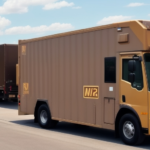Understanding UPS Rates for Domestic Shipping
If you're running a business that relies on shipping products domestically, it's essential to understand how UPS calculates and charges for its shipping services. This knowledge can help you optimize your shipping process, select the right UPS services for your needs, and reduce your shipping expenses. In this article, we'll delve into UPS rates for domestic shipping, exploring the factors that influence your shipping costs, how to choose the appropriate UPS services, and strategies to save money on your UPS shipments.
How UPS Calculates Domestic Shipping Rates
UPS determines domestic shipping rates based on several key factors, including:
- Package Weight: Heavier packages generally incur higher shipping costs.
- Package Dimensions: Larger packages may be subject to dimensional weight pricing.
- Distance Traveled: Longer distances typically result in higher shipping fees.
- Service Level: Faster delivery options like UPS Ground or UPS Next Day Air affect the overall cost.
For instance, shipping a package nationwide via UPS Ground will typically cost more than shipping the same package locally. Additionally, larger and heavier packages are more expensive to ship due to dimensional weight calculations.
UPS also offers various add-ons and services that can modify your shipping rate, such as signature confirmations, Saturday delivery, and insurance. These additional services provide flexibility but may increase the overall cost of shipping.
Moreover, the type of item being shipped plays a role in determining shipping rates. Hazardous materials, fragile items, and perishable goods may require special handling and packaging, leading to higher shipping costs. UPS provides comprehensive guidelines and restrictions for shipping these types of items, so it's crucial to consult their official guidelines before shipping.
Factors That Affect Your UPS Shipping Costs
Several elements can influence your overall UPS shipping costs. Key factors include:
- Size and Weight: Both the physical dimensions and weight of your package affect the cost. For example, a light but bulky package can be more expensive than a heavy but compact one due to dimensional weight pricing.
- Service Level: The chosen UPS service level (e.g., Ground, Air) impacts the shipping rate.
- Distance: The greater the distance your package travels, the higher the shipping cost.
- Fuel Surcharges: Fluctuations in fuel prices can lead to adjustments in shipping rates.
- Residential Delivery Fees: Delivering to residential addresses often incurs additional fees compared to commercial deliveries.
- Address Correction Fees: Incorrect or incomplete addresses may require UPS to reroute your package, resulting in extra charges.
Understanding these additional fees and surcharges is vital for accurately estimating your total shipping costs.
Additionally, the type of item you are shipping can influence costs. Items requiring special handling or packaging, such as fragile or high-value goods, may increase shipping expenses due to the need for extra care and materials.
Choosing the Right UPS Service for Your Domestic Shipping Needs
Selecting the appropriate UPS service is crucial for cost savings and operational efficiency. UPS offers a range of services, including:
- UPS Ground: A cost-effective option for non-urgent shipments with reliable delivery times.
- UPS Next Day Air: Ideal for time-sensitive shipments requiring fast delivery.
- UPS Freight: Suited for larger or heavier shipments that exceed standard size and weight limits.
When choosing a service, consider factors such as shipment urgency, package size and weight, and budget constraints. For time-sensitive deliveries, UPS Next Day Air is recommended. Conversely, if speed is not a priority, UPS Ground offers a more economical solution.
Furthermore, UPS provides various add-ons and services to customize your shipping experience. Assess your specific needs to leverage these options effectively.
It's also important to consider the destination of your shipments. While UPS primarily offers domestic services, they also provide international shipping options. If you plan to ship internationally, ensure you select a service that accommodates cross-border deliveries and includes customs brokerage services to navigate the complexities of international shipping.
Comparing UPS Ground vs. UPS Air Services: Pros and Cons
Both UPS Ground and UPS Air services have their unique advantages and drawbacks:
- UPS Ground:
- Pros: More affordable, reliable for non-urgent shipments, and has a lower environmental impact due to the use of ground transportation.
- Cons: Slower delivery times compared to air services.
- UPS Air:
- Pros: Faster delivery times, suitable for time-sensitive or perishable items, and offers more delivery options.
- Cons: Generally more expensive, especially for large or heavy shipments, and has a higher carbon footprint.
Choosing between these services depends on your specific shipping needs. For less time-sensitive deliveries, UPS Ground is a cost-effective choice. For urgent shipments, UPS Air ensures quicker delivery but at a higher cost.
Tips to Save Money on Your UPS Domestic Shipping Rates
Implementing the following strategies can help you reduce your UPS domestic shipping costs:
- Optimize Packaging: Use smaller, lighter packaging materials to decrease dimensional weight and overall shipping costs.
- Utilize Discounts and Promotions: Sign up for UPS's rewards program or negotiate rates based on your shipping volume to take advantage of available discounts.
- Leverage UPS Smart Pickup: Save time and money by arranging pickups directly from your location, eliminating the need to drop off packages at UPS locations.
- Use Online Shipping Tools: UPS's online tools allow you to compare rates, print shipping labels, and track packages efficiently, reducing the need for in-person visits.
- Choose Ground Shipping: When time permits, opt for UPS Ground instead of more expensive air shipping options.
Implementing these tips can lead to significant savings on your UPS shipping costs while maintaining efficient delivery processes.
Understanding Additional Fees and Surcharges on UPS Shipments
UPS applies various additional fees and surcharges that can impact your shipping costs. Common fees include:
- Residential Delivery Fees: Extra charges for delivering to residential addresses.
- Address Correction Fees: Fees incurred when UPS needs to correct an incomplete or incorrect address.
- Oversize Package Fees: Additional costs for packages that exceed standard size and weight limits.
- Fuel Surcharges: Variable fees based on current fuel prices.
To avoid these fees:
- Ensure packages are accurately labeled and addressed.
- Adhere to UPS's size and weight guidelines.
- Use UPS-approved packaging materials to meet specific requirements.
Understanding and mitigating these additional charges can help you better estimate and control your total shipping costs.
How to Track Your UPS Shipment and Monitor Delivery Progress
UPS provides several tools and services to help you track your shipments and monitor their delivery progress:
- UPS Website: Access real-time tracking information via the UPS tracking page.
- UPS Mobile App: Receive instant updates and track packages on-the-go through the UPS mobile application.
- Delivery Options: Schedule specific delivery dates or times, or reroute shipments to alternative addresses as needed.
Utilizing these tools ensures you stay informed about your shipments' status, allowing for better planning and customer communication.
Common Mistakes to Avoid When Shipping with UPS
To ensure smooth and cost-effective UPS shipments, avoid the following common mistakes:
- Poor Packaging and Labeling: Inadequate packaging can lead to damaged or lost packages, while incorrect labeling may result in additional fees or delivery delays.
- Unverified Addresses: Always double-check recipient addresses to prevent misdeliveries and address correction fees.
- Improper Declaration of Value: Accurately declare the value of your shipments to ensure appropriate insurance coverage.
- Neglecting UPS Tools and Services: Failing to utilize available UPS tools can result in missed opportunities for cost savings and process optimization.
By being mindful of these potential pitfalls, you can enhance your shipping efficiency and reduce the risk of incurring unnecessary costs.
Using Technology to Streamline Your UPS Domestic Shipping Process
Embracing technology can significantly enhance your UPS domestic shipping process, offering both time and cost savings. UPS provides various technological tools and services, including:
- WorldShip Software: Automates your shipping process, reducing manual entry errors and increasing efficiency.
- CampusShip: A web-based shipping solution ideal for e-commerce businesses, offering streamlined shipping operations and integration with popular e-commerce platforms.
- Shipping APIs: Integrate UPS's shipping functionalities directly into your business software or website, enabling automated shipping processes and real-time shipping updates for customers.
Leveraging these technologies can help automate your shipping workflows, reduce errors, and provide a seamless experience for both your business and your customers.
Understanding the Differences Between Dimensional Weight and Actual Weight
UPS calculates shipping costs based on either the actual weight or dimensional weight of your package, whichever is greater. Here's what each term means:
- Actual Weight: The direct weight of the package.
- Dimensional Weight: A pricing technique that considers a package's size and volume. It's calculated using the formula:
Dimensional Weight = (Length × Width × Height) / 139
(units are in inches and pounds).
For example, a package measuring 20x20x20 inches would have a dimensional weight of approximately 57.6 lbs, which may be higher than its actual weight. In such cases, UPS will charge based on the dimensional weight.
To avoid unexpected shipping costs, calculate the dimensional weight of your packages and compare it to the actual weight. Use the higher value for accurate shipping cost estimation.
How to Properly Package and Label Your Shipment for UPS Compliance
Proper packaging and labeling are critical to ensure your shipment arrives safely, on time, and without incurring additional fees. Follow these guidelines:
- Secure Packaging: Use sturdy boxes and cushioning materials to protect your items during transit. Ensure packages are sealed properly to prevent damage.
- Clear Labeling: Clearly label your package with both the recipient's and your return address. Use UPS-approved labels and ensure all information is legible.
- Comply with UPS Guidelines: Adhere to UPS's specific packaging requirements to avoid surcharges. Utilize UPS-provided packaging materials when necessary.
By ensuring your packages are well-packaged and accurately labeled, you enhance the likelihood of timely and safe deliveries while minimizing the risk of additional charges.
Navigating International Shipping with UPS: Tips and Tricks
International shipping introduces additional complexities, but UPS offers tools and services to simplify the process:
- Understand Destination Regulations: Familiarize yourself with the shipping rules, regulations, and restrictions of the destination country to ensure compliance.
- Use UPS International Shipping Services: These services provide comprehensive support for cross-border shipping, including customs documentation and clearance assistance.
- Estimate Shipping Costs: Utilize UPS's international shipping calculators to estimate costs accurately, considering factors like duty, taxes, and customs fees.
By leveraging UPS's international shipping solutions and staying informed about destination-specific requirements, you can navigate the complexities of global shipping effectively.
Understanding Insurance Options for Your Domestic Shipments with UPS
Protecting your domestic shipments against loss, damage, or theft is vital. UPS offers various insurance options to cater to different needs:
- Declared Value Coverage: Provides coverage up to the declared value of the package, ensuring you are reimbursed in case of loss or damage.
- UPS Liability Coverage: Offers coverage up to a specified amount based on the chosen service level, providing a safety net for standard shipments.
When selecting insurance options:
- Assess Shipment Value: Determine the value of the items being shipped to select appropriate coverage.
- Proper Packaging: Use secure packaging to minimize the risk of damage and support insurance claims if necessary.
- Accurate Declaration: Ensure that the declared value accurately reflects the shipment's worth to avoid discrepancies during claims.
Understanding and selecting the right insurance options can provide peace of mind and financial protection for your valuable shipments.
The Future of Domestic Shipping with UPS: Trends and Innovations
The landscape of domestic shipping is continually evolving, with UPS at the forefront of adopting new technologies and innovations:
- Automation and Robotics: UPS is increasingly utilizing automation and robotics in their sorting facilities to enhance efficiency and reduce shipping times.
- Drone Deliveries: Exploring the potential of drone technology to offer faster and more flexible delivery options, particularly in remote areas.
- Autonomous Ground Vehicles: Developing self-driving vehicles to streamline the last-mile delivery process, reducing labor costs and improving delivery speeds.
- Sustainability Initiatives: Investing in eco-friendly transportation methods and packaging materials to reduce the environmental impact of shipping operations.
These trends and innovations are set to revolutionize the shipping industry, making UPS services more efficient, reliable, and sustainable in the years to come.
In conclusion, understanding UPS rates for domestic shipping is fundamental to optimizing your shipping operations, selecting the appropriate UPS services, and managing your shipping costs effectively. By considering the various factors that influence shipping rates, utilizing available tools and services, and staying informed about industry trends, you can ensure your shipments arrive safely and on time while maintaining cost efficiency.




















